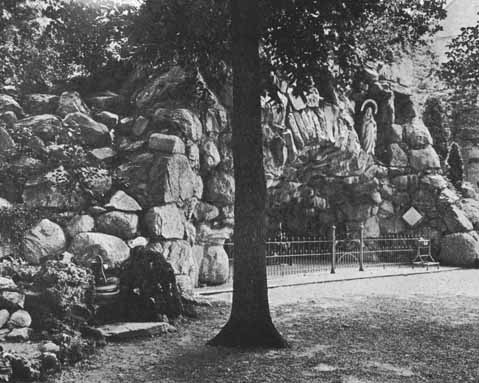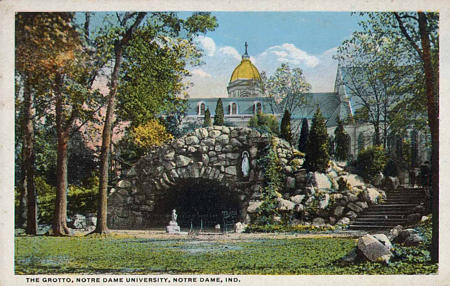
Notre Dame's Grotto / by Dorothy V. Corson


Ongoing News of the Newly Erected Grotto
Shortly after it was dedicated, an entry in the Scholastic described the new Grotto:
Constructed entirely of unhewn rocks, great boulders, some of them weighing as much as 2 to 3 tons go to make up the foundation and even near the keystone of the arch the stones are so large as to give the impression of instability.(160)
The South Bend Tribune capsuled a subsequent pilgrimage made to the newly erected Grotto of Lourdes at Notre Dame.
The annual pilgrimage from Kalamazoo to Notre Dame took place today. Two trains of 10 coaches each, all loaded with people (5 passengers from Mattawan, 66 from Lawton, 85 from Decatur, 114 from Dowagiac) came over and many of them attended services in the church of Sacred Heart. After services the excursionists visited the university and points of interest about the city.(161)
The Kalamazoo Augustinian also detailed this 1896 trip. It described how the first train from Kalamazoo reached Notre Dame at eight o'clock:
At Dowagiac Fr. Joos got aboard with a number of Indians which was an event of the trip. . . . Strangers from a distance were also on the train, even far off Detroit was well represented. . . . At the Grotto the procession halted and the usual prayers and offering of candles were made. The Grotto was a beautiful surprise. Although much had been promised, more than what was promised was realized. It is a wonderful creation. It was the favorite spot for the pilgrims throughout the day. The spring was tested and more than one favor was received. It was a day of joy, peace, devotion and happiness long to be remembered.(162)
The article ended with this interesting disclosure which indicated that the ordinary backyard pump placed over the spring at the Grotto, shown above,was immediately put to use:
Many gallons of water from the pump at the spring were carried away.
Although it is the only reference to this practice yet found, more than one local resident has mentioned how their ancestor never left church services without stopping at the Grotto for a drink at the fountain. The backyard pump was later replaced with a tall drinking fountain.
Since its dedication in 1896, many heartfelt descriptions of the newly erected Grotto have been published in the Scholastic.
The tall maples in the hollow, near the entrance to the Grotto are shedding their brown leaves and when the sun shines, cast ghostly shadows upon the rocky sides of the Grotto's walls. The place is fitted to inspire serious thought, and if you go there during the day you will find many kneeling in supplication on the rude benches before Mary's statue.(163)
A year later, in August of 1897, further work on the Grotto was mentioned.
The grotto is still unfinished. After it was found some months ago that the water got through it, the mound at the rear was taken away and the back newly cemented, covered with asphalt paper and tarred. Rain cannot penetrate it now, but the rear is still unfinished. The erection of a new mound would be a welcome relief from the desolate blackness that now confronts the visitor.(164)
The conclusion of Father Maguire's letter touches on this subject. He ends his letter with this last sentence:
The grotto was begun and completed in 1896 but each year little touches here and there have made it the beauty spot it is today, a place worthy of our Blessed Mother.
On December 28, 1897, a little over a year after the Grotto was dedicated, Rev. William Corby, C.S.C., the originator of the 1896 Grotto, died at Notre Dame, Indiana.
Five months later, on May 25, 1898, Father Thomas Carroll also died. The generosity of the priest from Oil City, Pennsylvania who financed the building of the Grotto is remembered in the Scholastic :
Out of the wealth that his business like methods enabled him to acquire, he founded one of the first scholarships at Notre Dame. In doing this he built for himself another monument that time can not destroy. No one knew better than he the need the Catholic young man has for education and no one was more willing than he to help the good work along. The scholarship at Notre Dame is only one of many that he directed to be founded in this country, in Italy and in Ireland.
Only three years ago the back of the Community house was nothing but a bare brown mound with an old willow and one or two poplar trees . . . . "Here in the quiet of the grove so close to the Church of the Sacred Heart was a location suitable in every respect." In a few months the Grotto was completed [1896]. Father Corby selected the site. Corby to Carroll "Let the Grotto be built here and let those that visit it say a prayer that God may grant us both a happy death." The Grotto was built there and now . . . both are dead, within months of each other.(165)
Five years after the completion of the Grotto, on December 28, 1901, at the age of 58, Robert Braunsdorf -- the architect who engineered the building of the Notre Dame Grotto -- died unexpectedly after a a brief illness. Just weeks before, he was conducting his duties as supervising architect at the new St. Paul's Episcopal Church. A huge piece of rose granite at the site caught his eye. Unknowing, he set it aside to keep for his future grave marker. Six weeks later, it was carved into a beautiful six foot rose granite cross that now marks his grave in the Cedar Grove Cemetery on Notre Dame Avenue adjacent to the University.(166)
It is unlikely the Grotto would ever have been accomplished without Robert Braunsdorf's know-how. That it is still standing after almost 100 years is evidence of his problem solving prowess. Over the years, a number of his descendants have also been associated with the University of Notre Dame.

Plaques at the Grotto
On June 30, 1907 a pilgrimage to the Notre Dame Grotto inspired a plaque placed at the Grotto to commemorate it. This plaque is long gone now, but its former presence there can still be seen on the left side of the Grotto. Its early existence would not have been known or remembered were it not for a Postcard Collectors Convention held in South Bend. Among postcards of Notre Dame, there was an early one of the Grotto postmarked, January 2, 1912. On the other side of it, was a friendly message dated New Years Day, 1912.
For a number of years it was the only plaque at the Grotto other than the donor plaque. There were several illegible lines of script on it. A search through old photographs of the Grotto produced only one photograph showing the plaque. Fortunately it was large enough to decipher the words with a magnifying glass. It read: "In remembrance of the First Pilgrimage from Holy Trinity Parish, Chicago, IL June 30, 1907." Below it was the same message in Polish.
Why the plaque was missing would have to remain a mystery. Perhaps it deteriorated in time, or came loose from the stone and was never remounted. It disappeared about 1920-21 leaving a diamond imprint on the Grotto from that time on.
About the same time, the first "For Favor Granted" plaque appeared at the Grotto, this time to commemorate the date, February 26, 1918. Beneath the date were the initials G.F. and A.M. The armistice was signed and World War I ended on November 11, 1918. Perhaps the plaque represented a prayer answered, for a young couple planning their future during wartime. Or it may have been placed there by two Notre Dame students upon their safe return. It is unique for three reasons. It was the first plaque, other than the donor plaque, placed on the Grotto; it has two sets of initials on it; and thirty-three years went by before a second "For Favor Granted" plaque appeared on the the Grotto.